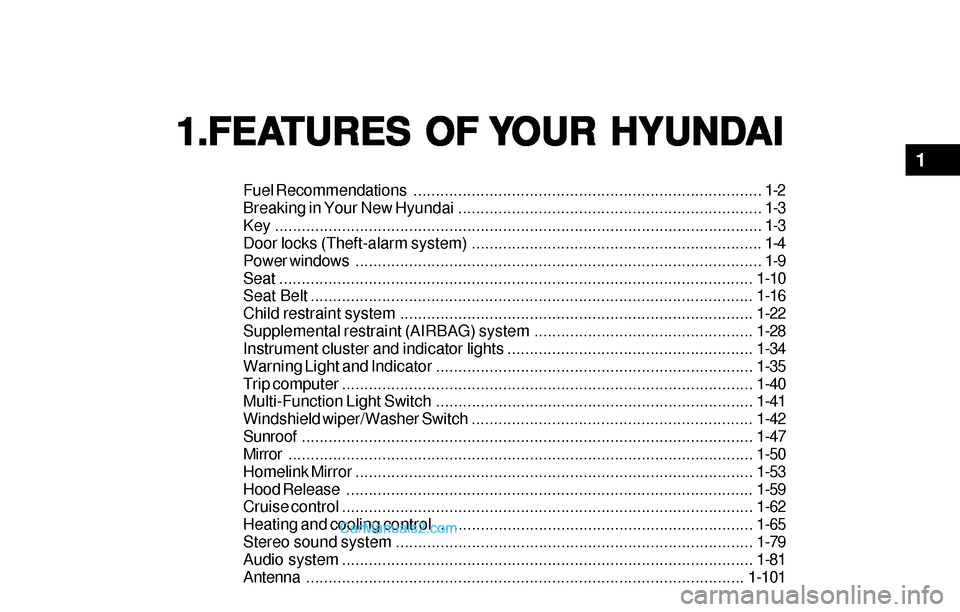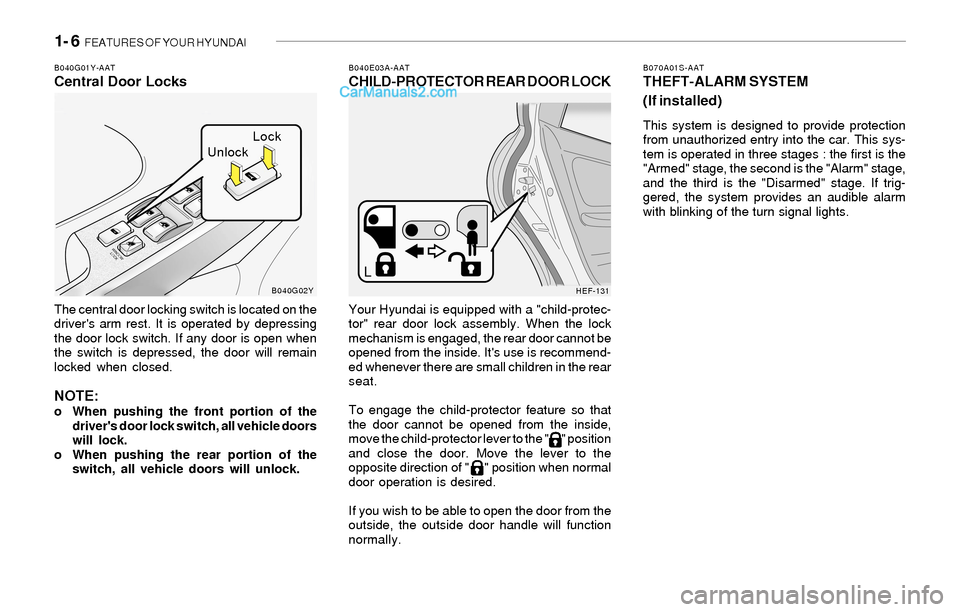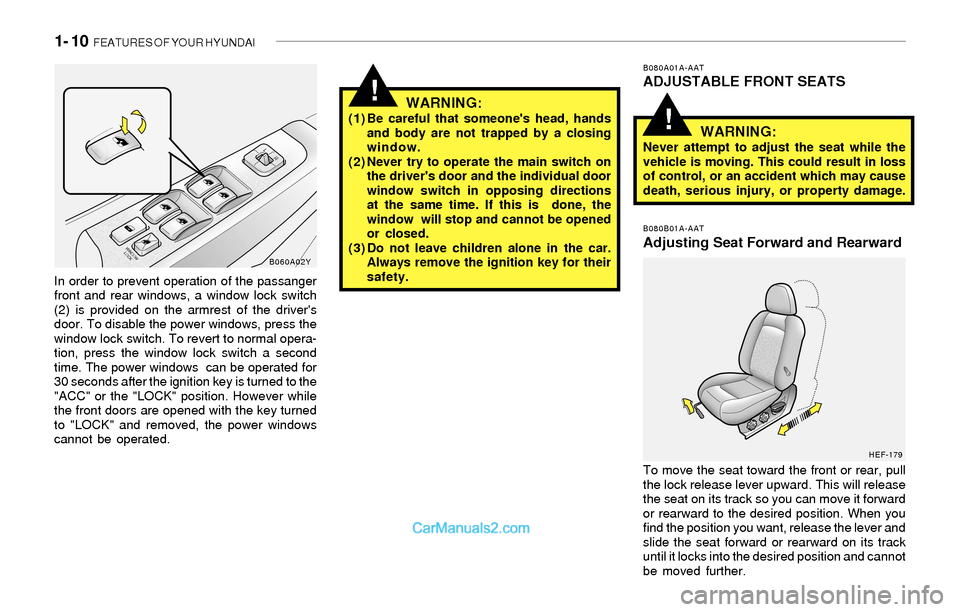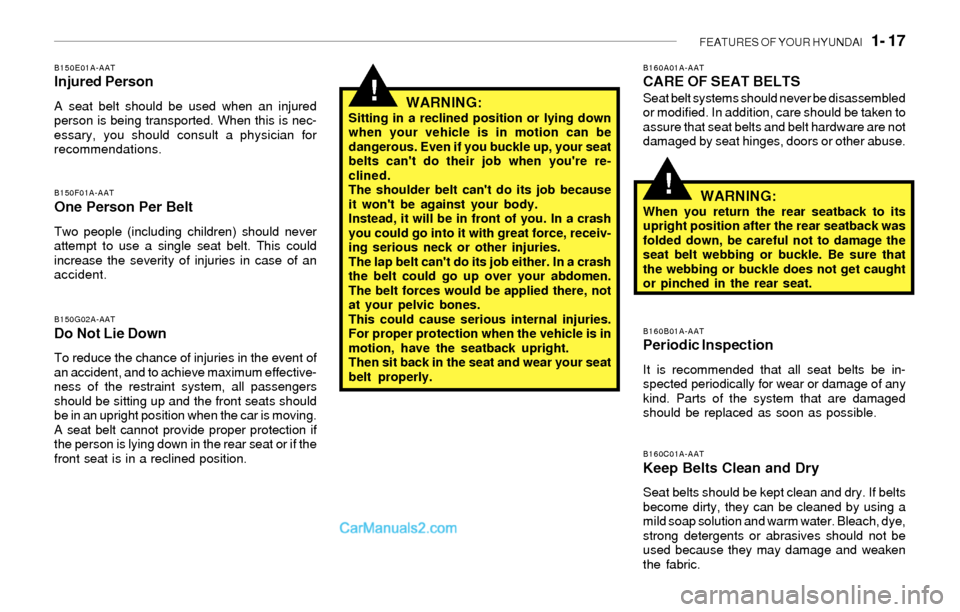2004 Hyundai Sonata child seat
[x] Cancel search: child seatPage 13 of 208

1.FEA 1.FEA1.FEA 1.FEA
1.FEA
TURES OF TURES OF TURES OF TURES OF
TURES OF
Y YY Y
Y
OUR HYUND OUR HYUNDOUR HYUND OUR HYUND
OUR HYUND
AI AIAI AI
AI
Fuel Recommendations.............................................................................. 1-2
Breaking in Your New Hyundai.................................................................... 1-3
Key ............................................................................................................. 1-3
Door locks (Theft-alarm system) ................................................................. 1-4
Power windows........................................................................................... 1-9
Seat..........................................................................................................1-10
Seat Belt...................................................................................................1-16
Child restraint system ...............................................................................1-22
Supplemental restraint (AIRBAG) system .................................................1-28
Instrument cluster and indicator lights.......................................................1-34
Warning Light and Indicator.......................................................................1-35
Trip computer............................................................................................1-40
Multi-Function Light Switch .......................................................................1-41
Windshield wiper/Washer Switch...............................................................1-42
Sunroof.....................................................................................................1-47
Mirror........................................................................................................1-50
Homelink Mirror.........................................................................................1-53
Hood Release...........................................................................................1-59
Cruise control............................................................................................1-62
Heating and cooling control .......................................................................1-65
Stereo sound system ................................................................................1-79
Audio system............................................................................................1-81
Antenna..................................................................................................1-101
1
Page 16 of 208

1- 4 FEATURES OF YOUR HYUNDAI
!
B030C01Y-AATILLUMINATED IGNITION SWITCH
(If installed)B040A01A-AATDOOR LOCKSB040B01A-AATLocking and unlocking front doors with a
key
Whenever a door is opened, the ignition switch
will be illuminated for your convenience, pro-
vided the ignition switch is not in the "ON"
position.
The light will go off approximately 10 seconds
after closing the door or when the ignition switch
is turned on.
B030C01L
o The door can be locked or unlocked with a
key.
o Lock the door by turning the key toward the
front of the vehicle and unlock it by turning the
key toward the rear.
NOTE:The driver's door can be unlocked by turn-
ing the key once toward the rear. If you wish
to unlock all doors, turn the key again
toward the rear within 4 seconds.
B040B01Y
LOCKUNLOCK
WARNING:o Unlocked doors can be dangerous. Be-
fore you drive away (especially if there
are children in the car), be sure that all the
doors are securely closed and locked so
that the doors cannot be opened from
the inside. This helps assure that doors
will not be opened accidentally. Also,
when combined with the proper use of
seat belts, locking the doors helps keep
occupants from being ejected from the
car in case of an accident.
o Before opening the door, always look for
and avoid oncoming traffic.
Page 18 of 208

1- 6 FEATURES OF YOUR HYUNDAI
B070A01S-AATTHEFT-ALARM SYSTEM
(If installed)
This system is designed to provide protection
from unauthorized entry into the car. This sys-
tem is operated in three stages : the first is the
"Armed" stage, the second is the "Alarm" stage,
and the third is the "Disarmed" stage. If trig-
gered, the system provides an audible alarm
with blinking of the turn signal lights.
B040G01Y-AATCentral Door Locks
The central door locking switch is located on the
driver's arm rest. It is operated by depressing
the door lock switch. If any door is open when
the switch is depressed, the door will remain
locked when closed.
NOTE:o When pushing the front portion of the
driver's door lock switch, all vehicle doors
will lock.
o When pushing the rear portion of the
switch, all vehicle doors will unlock.
B040E03A-AATCHILD-PROTECTOR REAR DOOR LOCK
Your Hyundai is equipped with a "child-protec-
tor" rear door lock assembly. When the lock
mechanism is engaged, the rear door cannot be
opened from the inside. It's use is recommend-
ed whenever there are small children in the rear
seat.
To engage the child-protector feature so that
the door cannot be opened from the inside,
move the child-protector lever to the " " position
and close the door. Move the lever to the
opposite direction of " " position when normal
door operation is desired.
If you wish to be able to open the door from the
outside, the outside door handle will function
normally.
B040G02Y
HEF-131
Lock
Unlock
Page 22 of 208

1- 10 FEATURES OF YOUR HYUNDAI
!
In order to prevent operation of the passanger
front and rear windows, a window lock switch
(2) is provided on the armrest of the driver's
door. To disable the power windows, press the
window lock switch. To revert to normal opera-
tion, press the window lock switch a second
time. The power windows can be operated for
30 seconds after the ignition key is turned to the
"ACC" or the "LOCK" position. However while
the front doors are opened with the key turned
to "LOCK" and removed, the power windows
cannot be operated.
WARNING:(1) Be careful that someone's head, hands
and body are not trapped by a closing
window.
(2) Never try to operate the main switch on
the driver's door and the individual door
window switch in opposing directions
at the same time. If this is done, the
window will stop and cannot be opened
or closed.
(3) Do not leave children alone in the car.
Always remove the ignition key for their
safety.
B080A01A-AATADJUSTABLE FRONT SEATS
WARNING:
Never attempt to adjust the seat while the
vehicle is moving. This could result in loss
of control, or an accident which may cause
death, serious injury, or property damage.
B080B01A-AAT
Adjusting Seat Forward and Rearward
To move the seat toward the front or rear, pull
the lock release lever upward. This will release
the seat on its track so you can move it forward
or rearward to the desired position. When you
find the position you want, release the lever and
slide the seat forward or rearward on its track
until it locks into the desired position and cannot
be moved further.
B060A02Y
HEF-179
!
Page 28 of 208

1- 16 FEATURES OF YOUR HYUNDAI
!
!
B150C02A-AATLarger Children
Children who are too large for child restraint
systems should occupy the rear seat and use
the available lap/shoulder belts. The lap portion
should be fastened snug on the hips and as low
as possible. Check belt fit periodically. A child's
squirming could put the belt out of position.
Children are afforded the most safety in the
event of an accident when they are restrained
by a proper restraint system in the rear seat. If
a larger child (over age 13) must be seated in
the front seat, the child should be securely
restrained by the available lap/shoulder belt and
the seat should be placed in the rearmost
position. Children under the age of 13 should be
restrained securely in the rear seat. NEVER
place a rear facing child seat in the front seat of
a vehicle.
B150D01A-AATPregnant Women
The use of a seat belt is recommended for
pregnant women to lessen the chance of injury
in an accident. When a seat belt is used, the lap
belt portion should be placed as low and snugly
as possible on the hips, not across the abdo-
men. For specific recommendations, consult a
physician.
B150A02A-AATSEAT BELT PRECAUTIONSB150B03Y-AATInfant or Small ChildAll 50 states have child restraint laws. You
should be aware of the specific requirements in
your state. Child and/or infant safety seats must
be properly placed and installed in the rear seat.
Information about the use of these restraints
begins on page 1-22.
WARNING:Every person in your vehicle needs to be
properly restrained at all times, including
infants and children. In a collision, an unre-
strained child can become a "missile" in-
side the car. The force required to hold a
child on your lap could be so great that you
could not hold the child. Any child riding in
the vehicle should always be in a proper
restraint in the rear seat of the vehicle.
NOTE:Small children are best protected from in-
jury in an accident when properly restrained
in the rear seat by a child restraint system
that meets the requirements of the Federal
Motor Vehicle Safety Standards. Before
buying any child restraint system, make
sure that it has a label certifying that it
meets Motor Vehicle Safety Standard 213.
The restraint must be appropriate for your
child's height and weight. Check the label
on the child restraint for this information.
See page 1-22.
WARNING:All occupants of the vehicle must wear their
seat belts at all times. Note that this vehicle
is equipped with a Supplemental Restraint
(Airbag) System as discussed beginning
on page 1-28. The seat belts must be used
in conjunction with the supplemental
airbag system. State laws require that some
or all occupants of the vehicle use seat
belts. The possibility of increased injury or
severity of injury in an accident will be
increased if this elementary safety precau-
tion is not observed.
In addition, follow the other instructions
provided in this section.
Page 29 of 208

FEATURES OF YOUR HYUNDAI 1- 17
!
!
B150E01A-AATInjured Person
A seat belt should be used when an injured
person is being transported. When this is nec-
essary, you should consult a physician for
recommendations.
B150F01A-AAT
One Person Per Belt
Two people (including children) should never
attempt to use a single seat belt. This could
increase the severity of injuries in case of an
accident.
WARNING:Sitting in a reclined position or lying down
when your vehicle is in motion can be
dangerous. Even if you buckle up, your seat
belts can't do their job when you're re-
clined.
The shoulder belt can't do its job because
it won't be against your body.
Instead, it will be in front of you. In a crash
you could go into it with great force, receiv-
ing serious neck or other injuries.
The lap belt can't do its job either. In a crash
the belt could go up over your abdomen.
The belt forces would be applied there, not
at your pelvic bones.
This could cause serious internal injuries.
For proper protection when the vehicle is in
motion, have the seatback upright.
Then sit back in the seat and wear your seat
belt properly.
B150G02A-AATDo Not Lie Down
To reduce the chance of injuries in the event of
an accident, and to achieve maximum effective-
ness of the restraint system, all passengers
should be sitting up and the front seats should
be in an upright position when the car is moving.
A seat belt cannot provide proper protection if
the person is lying down in the rear seat or if the
front seat is in a reclined position.
B160A01A-AATCARE OF SEAT BELTSSeat belt systems should never be disassembled
or modified. In addition, care should be taken to
assure that seat belts and belt hardware are not
damaged by seat hinges, doors or other abuse.
WARNING:When you return the rear seatback to its
upright position after the rear seatback was
folded down, be careful not to damage the
seat belt webbing or buckle. Be sure that
the webbing or buckle does not get caught
or pinched in the rear seat.
B160B01A-AATPeriodic Inspection
It is recommended that all seat belts be in-
spected periodically for wear or damage of any
kind. Parts of the system that are damaged
should be replaced as soon as possible.
B160C01A-AATKeep Belts Clean and Dry
Seat belts should be kept clean and dry. If belts
become dirty, they can be cleaned by using a
mild soap solution and warm water. Bleach, dye,
strong detergents or abrasives should not be
used because they may damage and weaken
the fabric.
Page 31 of 208

FEATURES OF YOUR HYUNDAI 1- 19
!
B190A01Y-AAT
SEAT BELTS-Front Passenger and Rear
Seat 3-Point System with Combination
Locking Retractor
To Fasten Your Belt
Combination retractor type seat belts are in-
stalled in the rear seat positions to help accom-
modate the installation of child restraint sys-
tems. Although a combination retractor is also
installed in the front passenger seat position,
Hyundai strongly recommends that children
always be seated in the rear seat. NEVER place
any infant restraint system in the front seat of the
vehicle.
This type of seat belt combines the features of
both an emergency locking retractor seat belt
and an automatic locking retractor seat belt. To
fasten your seat belt, pull it out of the retractor
and insert the metal tab into the buckle. There
will be an audible "click" when the tab locks into
the buckle. When not securing a child restraint,
the seat belt operates in the same way as the
driver's seat belt (Emergency Locking Retrac-tor Type). It automatically adjusts to the proper
length only after the lap belt portion of the seat
belt is adjusted manually so that it fits snugly
around your hips. When the seat belt is fully
extended from the retractor to allow the instal-
lation of a child restraint system, the seat belt
operation changes to allow the belt to retract, but
not to extend. (Automatic Locking Retractor
Type). See page 1-24.
NOTE:Although the combination retractor pro-
vides the same level of protection for seated
passengers in either emergency or auto-
matic locking modes, it is recommended
that seated passengers use the emergency
locking feature for improved convenience.
The automatic locking function is intended
to facilitate child restraint installation. To
convert from the automatic locking feature
to the emergency locking operation mode,
allow the unbuckled seat belt to fully re-
tract.
WARNING:o For maximum restraint system protec-
tion, the seat belts must always be used
whenever the car is moving.
o Seat belts are most effective when
seatbacks are in the upright position.
o Children must always be seatbelted in
the rear seats. Never allow children to
ride in the front passanger seat.
o The shoulder belt should be positioned
midway over the shoulder nearest the
door for the most effective protection.
Never wear the seat belt under the arm
nearest the door. Wearing the belt under
the arm nearest the door could cause
serious or fatal injuries in an accident.
o Avoid wearing twisted seat belts. A
twisted belt can't do its job as well. In a
collision, it could even cut into you. Be
sure the belt is straight and not twisted.
o Be careful not to damage the belt web-
bing or hardware. If the belt webbing or
hardware is damaged, replace it.
NOTE:Seat belt reminder light comes and stays on
until the seat belt is fastened when the
ignition key is turned "ON" or "START".
And, the warning chime will also sound for
about 6 seconds.
Page 34 of 208

1- 22 FEATURES OF YOUR HYUNDAI
!
B230A02Y-AATCHILD RESTRAINT SYSTEM
Children riding in the car should sit in the rear
seat and must always be properly restrained to
minimize the risk of injury in an accident, sudden
stop or sudden maneuver. According to acci-
dent statistics provided by the National High-
way Traffic Safety Administration (NHTSA),
children are safer when properly restrained in
the rear seats than in the front seat. Larger
children should use one of the seat belts pro-
vided.
All 50 states have child restraint laws. You
should be aware of the specific requirements in
your state. Child and/or infant safety seats must
be properly placed and installed in the rear seat.
You must use a commercially available child
restraint system that meets the requirements of
the Federal Motor Vehicle Safety Standards
(FMVSS).
Children could be injured or killed in a crash if
their restraints are not properly secured. For
small children and babies, a child seat or infant
seat must be used. Before buying a particular
child restraint system, make sure it fits your car
and seat belts, and fits your child. Follow all the
instructions provided by the manufacturer when
installing the child restraint system.WARNING:o A child restraint system must be placed
in the rear seat. Never install a child or
infant seat on the front passenger's seat.
Should an accident occur and cause the
passenger side airbag to deploy, it could
severely injure or kill an infant or child
seated in an infant or child seat. thus,
only use a child restraint in the rear seat
of your vehicle.
o Since a safety belt or child restraint sys-
tem can become very hot if it is left in a
closed vehicle, be sure and check the
seat cover and buckles before placing a
child there.
o When the child restraint system is not in
use, store it in the trunk or fasten it with
a safety belt so that it will not be thrown
forward in the case of a sudden stop or
an accident.
o Children who are too large to be in a child
restraint should still sit in the rear seat
and be restrained with the available lap/
shoulder belts. Never allow children to
ride in the front passenger seat.
o Always make sure that the shoulder belt
portion of the lap/shoulder belt is posi-
tioned midway over the shoulder and
never across the neck or behind the
back. Moving the child closer to the
center of the vehicle may help provide a
good shoulder belt fit. The lap belt por-tion of the lap/shoulder belt must always
be positioned as low as possible on the
child's hips, and as snug as possible.
o If the seat belt will not properly fit the
child, we recommend the use of an ap-
proved booster seat in the rear seat in
order to raise the child's seating height
so that the seat belt will properly fit the
child.
Before purchasing a booster seat, make
sure that it meets applicable Federal
Motor Vehicle Safety Standards and that
it is satisfactory for use with this vehicle.
o Never allow a child to stand up or kneel
on the seat.
o Never use an infant carrier or a child
safety seat that "hooks" over a seatback;
it may not provide adequate security in
an accident.
o Never allow a child to be held in a person's
arms while they are in a moving vehicle,
as this could result in serious injury to
the child in the event of an accident or a
sudden stop. Holding a child in a moving
vehicle does not provide the child with
any means of protection during an acci-
dent, even if the person holding the child
is wearing a seat belt.